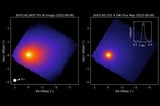Interstellar Comet 3I/ATLAS Reveals Unprecedented CO2-Rich Signature, Suggesting Unique Formation Origins
August 27, 2025
Interstellar comet 3I/ATLAS shows a CO2-rich signature, suggesting its formation in a planetary system with more CO2 ice relative to water ice than our Solar System.
The coma’s CO2 dominance implies the nucleus may be intrinsically CO2-rich or formed near the CO2 ice line in its parent star’s protoplanetary disk, pointing to formation under conditions different from those in the Solar System.
The comet remains observable through mid-2026, allowing continued study to refine its origin and nature.
The James Webb Space Telescope observed interstellar comet 3I/ATLAS in early August from about three astronomical units from the Sun.
Alternative explanations, such as water being buried deeper or the object passing near another star, are possible but less likely and require further investigation.
The lack of detectable water in the coma points to unusual surface properties or an insulating crust that may shield the icy interior.
3I/ATLAS could be the oldest interstellar comet discovered and may originate from an older, low-metallicity star system in the Milky Way’s thick disk.
These findings add to a growing view of the diversity of planetary system formation and the origins of interstellar objects.
Researchers suggest the host system may have experienced early water vapor loss or distinctive dust/gas dynamics that shaped the volatile makeup.
Its formation environment and compositional traits appear to differ from typical Solar System comets, offering clues about distant planetary systems.
JWST’s NIRSpec measurements of the coma reveal a high carbon dioxide to water ratio, unprecedented among comets observed to date.
Quantitatively, the coma shows an 8:1 CO2-to-water ratio, about 16 times higher than is typical for comets at similar distances from the Sun.
Summary based on 2 sources
Get a daily email with more Science stories
Sources

Gizmodo • Aug 27, 2025
This Visiting Interstellar Comet Just Keeps Getting Weirder
New Scientist • Aug 26, 2025
JWST gets a closer look at interstellar comet 3I/ATLAS